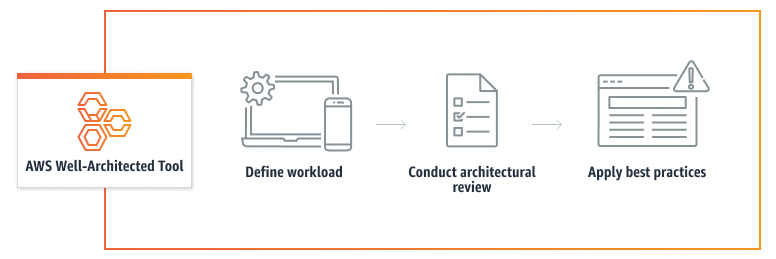To an outsider, the issue of reliability when it comes to cloud computing might seem like the boring sibling compared to more obvious issues like protecting your network from hackers, saving money or even making your operations more environment friendly. However, once you’ve been in the game for a while, you’ll see that reliability is more like a dependable Clark Kent who just gets things done in the background — and (every once in a while) it’s a bit like a superhero!

“That’s a very bold claim!” you sceptics cry, but it’s probably even only a slight exaggeration. Sure, you won’t actually hear people say “Is that a bird? Is that a plane? No, it’s the Reliability Pillar of the AWS Well-Architected Framework.” But the reality can be just as impressive, where a well-designed system can be the one that saves your business and your reputation and, yes, it sometimes even saves lives by keeping critical systems operational.
A Brief overview of the AWS Well-Architected Framework
First things first though. Just what is this Reliability Pillar that I mentioned? This pillar is part of what is known as the AWS Well-Architected Framework: a set of guidelines and best practices from Amazon Web Services (AWS) to help you build rock-solid, efficient, and secure cloud architectures.
The framework consists of six so-called "pillars”, including operational excellence, security, cost optimization, performance efficiency, sustainability, and of course reliability, each serving as a crucial aspect to ensure a robust and efficient cloud architecture.
The Reliability Pillar: Boring sibling or superhero?
The Reliability Pillar focuses on maintaining consistent system performance and availability, reducing downtime and service interruptions. As I suggested at the beginning, it’s easy to assume that reliability is less exciting than the other areas but, in reality, it’s an aspect of excellence that forms the bedrock of many successful business across all sectors.
Indeed, reliability plays a pivotal role in the success of cloud architecture by ensuring that digital services and applications are consistently available, perform efficiently, and are resistant to failures. In essence, reliability is the foundation upon which businesses build their digital success in the cloud — and sometimes it’s even the superhero that comes to your rescue!

Not-So-Boring: How reliability intertwines with other aspects of the framework
As with other areas of IT, it can be tempting to see things purely in terms of the technical and practical aspects. Certainly, there’s no question that service breakdowns will mean an immediate and direct hit to productivity, and the negative financial consequences need little explanation.
However, the deepest and most lasting effects on your business extend beyond technical issues, Including the loss of customers and the potential for long-term competitive disadvantage. Unlike technical problems, these business-related impacts can be challenging to address or even unfixable without serious effort and financial outlay.
Reliability: Directly impacting user experience and business success
Furthermore, reliability directly impacts user experience and, in turn, profoundly influences the success of a business. In an era where consumers demand uninterrupted access to digital services, a reliable system ensures that customers have a seamless and satisfying experience. Downtime, glitches, or slow performance can lead to user frustration, decreased engagement, and, ultimately, abandonment of a service or platform. From a business perspective, these disruptions directly impact critical goals.
A reliable architecture not only retains existing customers but also attracts new ones through positive word-of-mouth and helps build the trust and loyalty that are key drivers of long-term revenue and sustainable growth — serving as a linchpin for achieving business objectives.
What drives reliability?
According to the Amazon white paper on the Reliability Pillar, “the reliability of a workload in the cloud depends on several factors, the primary of which is Resiliency.�”
“Resiliency is the ability of a workload to recover from infrastructure or service disruptions, dynamically acquire computing resources to meet demand, and mitigate disruptions, such as misconfigurations or transient network issues.”
Without question there are other important factors, including Operational Excellence, Security, Performance Efficiency and Cost Optimisation, but resiliency is always at the heart of a reliable system and is worth our exclusive attention here.
How to increase resilience and reliability
So, how do you make a system resilient? Whilst the range of things that need to be resilient and reliable in a cloud workload can seem to be almost endless, one of the key benefits of using a framework is that it helps to make things more manageable and methodical in approach. As such, AWS outline the following four key considerations for reliability in the cloud:

- Foundations
- Workload Architecture
- Change Management
- Failure Management
In their documentation on the Well-Architected Framework, they go on to explain that “to achieve reliability you must start with the foundations — an environment where service quotas and network topology accommodate the workload. The workload architecture of the distributed system must be designed to prevent and mitigate failures. The workload must handle changes in demand or requirements, and it must be designed to detect failure and automatically heal itself.”
Design principles & Best Practices
In addition to main considerations to be aware of, AWS also identify a number of general design principles that can help you increase reliability. These included that you should automate recovery with proactive monitoring, test and simulate failures for risk reduction, scale workloads horizontally for availability, prevent resource saturation, and ensure consistent infrastructure changes through automation.

Review your architecture and put theory intro practice.
Whilst this can be a lot to take in, putting reliability into practice is paramount for the success of your cloud workloads. To make the process more manageable, it’s a good idea to start with a comprehensive Well-Architected Framework Review (WAFR) and integrate these principles from the beginning, ensuring that reliability is ingrained into the core of your architecture.
However, if you're looking for some general guidelines to enhance reliability in your cloud workloads, there are some key practices to consider.
- Use multiple Availability Zones: Deploy your AWS resources across multiple Availability Zones to protect them from zonal outages.
- Use load balancers: Use load balancers to distribute traffic across your AWS resources and to provide high availability.
- Use managed services: Use AWS managed services whenever possible to reduce the operational burden of managing your infrastructure.
- Automate your operations: Automate your operations and recovery procedures to reduce the risk of human error and to improve speed and efficiency.
- Implement continuous integration and continuous delivery (CI/CD): Use CI/CD to automate your software development and deployment process, which can help you to identify and fix problems early and to release new features to your customers more quickly.

Reliability in practice
So, the theory is great, and the tips are useful, but who uses this stuff to make a difference? Well, in real-world scenarios, the Reliability Pillar of the AWS Well-Architected Framework is a critical factor in maintaining uninterrupted services. For instance, Netflix, the global streaming giant, utilizes this pillar to achieve an impressive 99.99% uptime, ensuring constant availability of its vast content library and helping to set them aside as a quality service worth paying for.
Likewise, Airbnb relies on the Reliability Pillar to secure a 99.95% uptime, providing travellers with continuous access to its platform and giving people the confidence that they need when making an important booking. Capital One, a major player in digital banking, also benefits from this framework, achieving a remarkable 99.99% uptime, allowing its customers seamless access to banking services and underscoring how the Reliability Pillar ensures consistent and reliable services, benefiting businesses and customers alike.
Singing the praises of reliability
As we can see, reliability within the AWS Well-Architected Framework isn't the dull cousin of cloud computing after all! It's the unsung hero, quietly ensuring that digital services perform consistently and efficiently in clear and important ways for your business:
- Guarantees systems are resilient.
- Reduces downtime.
- Safeguards digital reputation.
Reliability not only retains customers but attracts new ones through positive word-of-mouth, bolsters user trust, and drives long-term revenue. In essence, it forms the foundation of digital success in the cloud.
Further Reading
- What is the Well-Architected Framework?
The AWS Well-Architected Framework is a tool to help cloud design but what does it do exactly? We discuss the key elements and how it can benefit you. - Why do I need an AWS Well Architected Review?
An introduction to the AWS Well-Architected Framework, discussing its benefits, and highlighting the advantages of conducting a Well-Architected Review with external experts for optimizing cloud infrastructure. - Reliability Pillar - AWS Well-Architected Framework
“The focus of this paper is the reliability pillar of the AWS Well-Architected Framework. It provides guidance to help customers apply best practices in the design, delivery, and maintenance of Amazon Web Services (AWS) environments.”
Enhance Reliability with Our Well-Architected Review
Elevate the reliability of your AWS infrastructure by embracing our Well-Architected Review service. Our team specializes in fortifying your cloud architecture for optimal reliability, ensuring your digital services remain consistently available and resilient. Start your journey towards reliability today!

